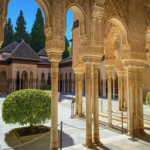Personalized itineraries are becoming increasingly popular among travellers who want to explore the beautiful region of Andalucia, Spain. Andalucia is a diverse region, with stunning coastlines, mountain ranges, and historic cities such as Seville, Granada, and Cordoba. One of the most popular destinations in Andalucia is Marbella, a town located on the Costa del Sol, which is renowned for its luxury resorts, beaches, and nightlife.

Travellers who want to explore Andalucia and Marbella in a more personalized way can benefit from using local itinerary planners. These experts can help travellers create a tailored itinerary that suits their interests, preferences, and budget. They can provide insider knowledge and recommendations on the best places to visit, eat, and stay, as well as arrange transportation, tours, and activities. With a personalized itinerary, travellers can make the most of their time in Andalucia and Marbella and have a more authentic and memorable experience.
If you’re planning a trip to Andalucia or Marbella, consider using a local itinerary planner to help you create a personalized itinerary. With their expertise and knowledge, you can discover hidden gems, avoid tourist traps, and experience the best that Andalucia and Marbella have to offer. Whether you’re interested in history, culture, food, or adventure, a personalized itinerary can be tailored to your interests and needs. So why not make your trip to Andalucia and Marbella unforgettable with a personalized itinerary?
Exploring Marbella and Its Charms
When it comes to planning a personalized itinerary in Marbella, there’s no shortage of things to see and do. From the historic Old Town to the luxurious Puerto Banus Marina, Marbella offers a perfect blend of culture, history, and beach life. Here are some of the highlights of what you can expect to see and experience during your visit.
Discovering the Old Town and Historical Sites
One of the best ways to experience the charm of Marbella is by exploring its Old Town. The Plaza de los Naranjos is a must-visit spot, with its beautiful orange trees, historic buildings, and bustling cafes. Stroll through the narrow streets and alleys, and discover the hidden gems of the town’s rich history.
Other must-see historical sites in Marbella include the Moorish Castle, the Roman Bridge, and the Alameda Park. Each of these sites offers a unique glimpse into the town’s rich and diverse past.
Beach Life and Coastal Attractions
No visit to Marbella would be complete without spending some time on its stunning beaches. From the popular La Fontanilla beach to the secluded Playa de los Monteros, there’s a beach for everyone in Marbella. Whether you’re looking to swim, sunbathe, or simply relax, Marbella’s beaches are the perfect place to do it.
In addition to its beaches, Marbella offers a wide range of coastal attractions. Take a boat tour to explore the stunning coastline, or try your hand at water sports like jet skiing and parasailing. And if you’re looking for a more laid-back experience, head to one of the town’s beach clubs, where you can enjoy a drink or a meal while taking in the beautiful views.
Marbella’s Luxurious Side: Puerto Banus Marina
For those looking for a touch of luxury, the Puerto Banus Marina is a must-visit spot. This exclusive marina is home to some of the world’s most expensive yachts, and is surrounded by high-end shops, restaurants, and bars. Take a stroll along the marina and soak up the glamorous atmosphere, or enjoy a drink at one of the many waterfront bars.
In conclusion, Marbella is a beautiful town that has something for everyone. Whether you’re interested in history, culture, or beach life, Marbella offers a perfect blend of all three. So, why not plan your personalized itinerary today and experience the charms of this stunning town for yourself?
The Andalucian Experience: Culture, Cuisine, and Activities
When it comes to experiencing the best of Andalucia, there’s no shortage of things to do and see. From the vibrant culture to the mouth-watering cuisine and outdoor adventures, there’s something for everyone in this beautiful region.
Cultural Highlights: Flamenco and Festivals
Andalucia is known for its rich cultural heritage, and one of the most iconic aspects of this heritage is flamenco. A flamenco show is a must-see experience that will leave you breathless, and there are plenty of venues throughout the region where you can catch a performance. In addition to flamenco, Andalucia is also home to a number of festivals throughout the year, such as the Feria de Abril in Seville and the Carnival of Cadiz. These festivals are a great way to experience the local culture and traditions, and they offer a lively atmosphere that is sure to leave a lasting impression.
Gastronomic Delights: Tapas and Local Flavours
When it comes to food, Andalucia is a true gastronomic paradise. The region is famous for its tapas, which are small dishes that are perfect for sharing with friends and family. Some of the most popular tapas include patatas bravas, croquetas, and tortilla española. In addition to tapas, Andalucia is also known for its local flavours, such as Iberian ham, olive oil, and sherry. A food tour is a great way to discover these local delicacies and learn about the region’s culinary traditions.
Outdoor Adventures: From Ronda to the Sierra Nevada
For those who love the great outdoors, Andalucia offers plenty of opportunities for adventure. One of the most popular destinations is Ronda, a picturesque town that is perched on a cliff and offers stunning views of the surrounding countryside. Another great option is the Sierra Nevada mountains, which offer a wide range of activities, such as hiking, skiing, and mountain biking. Whether you’re an adrenaline junkie or just looking for a relaxing day in nature, Andalucia has something for everyone.
In conclusion, Andalucia is a region that is rich in culture, cuisine, and outdoor adventures. Whether you’re interested in flamenco, tapas, or hiking in the mountains, there’s something for everyone in this beautiful part of Spain. So why not come and experience it for yourself? We guarantee you won’t be disappointed.
Planning Your Journey: Itineraries and Transportation
When planning a trip to Southern Spain, it’s important to consider both your itinerary and transportation options. Crafting the perfect Andalucia itinerary can be a daunting task, but with a little research and planning, you can create a trip that suits your interests, budget, and timeline.
Crafting the Perfect Southern Spain Itinerary
Start by deciding which destinations you want to visit. Marbella, Ronda, Cadiz, Jerez de la Frontera, Seville, Carmona, Ecija, Antequera, Cordoba, Granada, and Nerja are all popular stops on an Andalucia road trip. Consider the amount of time you have and how far you want to travel each day.
Once you have an idea of your itinerary, it’s time to start booking accommodations. There are many options available, from budget-friendly hostels to luxury hotels. Look for lodging that is centrally located and offers easy access to public transportation or major highways if you plan on renting a car.
When planning your itinerary, don’t forget to factor in time for meals, rest breaks, and unexpected delays. Consider booking activities and tours in advance to ensure availability and to save time.
Navigating Andalucia: Transport Options
There are several transportation options available for exploring Andalucia. If you intend to rent a car, be sure to familiarize yourself with the local driving laws and customs. Keep in mind that parking can be difficult in some areas, and you may encounter tolls on major highways.
Public transportation is also available, with buses and trains connecting major cities and towns. This can be a cost-effective option, but it may not be as convenient as having your own vehicle.
Ultimately, the best transportation option for your trip will depend on your itinerary, budget, and personal preferences. Consider all of your options before making a decision.
Frequently Asked Questions
What are the must-visit destinations for a 7-day road trip in Andalucia?
If you have a week to explore Andalucia, there are several must-visit destinations that you should include in your itinerary. Start in Malaga, and explore its historic centre, including the Alcazaba fortress and the Picasso Museum. From there, head to Granada to visit the Alhambra Palace and the Generalife Gardens. Then, travel to Cordoba to see the Mezquita-Catedral and the Alcazar de los Reyes Cristianos. Finally, end your trip in Seville, where you can explore the Alcazar, the Cathedral, and the Plaza de España.
How can I optimise my itinerary for a 10-day self-drive tour of Andalucia?
With 10 days to explore Andalucia, you can take a more leisurely pace and visit some off-the-beaten-track destinations. Start in Malaga, and then head to Ronda to see its famous bridge and historic bullring. From there, travel to Jerez de la Frontera to visit its sherry bodegas and watch a flamenco show. Then, head to Cadiz to explore its historic centre and beautiful beaches. Finally, end your trip in Seville, where you can spend several days exploring the city’s many sights and attractions.
Can you suggest an efficient route map for a 5-day Andalucia road trip?
With only 5 days to explore Andalucia, it’s best to focus on a few key destinations. Start in Malaga, and then head to Granada to visit the Alhambra Palace and the Generalife Gardens. From there, travel to Cordoba to see the Mezquita-Catedral and the Alcazar de los Reyes Cristianos. Finally, end your trip in Seville, where you can explore the Alcazar, the Cathedral, and the Plaza de España.
What are the top highlights for a 14-day exploration of Andalucia by car?
With 14 days to explore Andalucia, you can really get off the beaten path and see some of the region’s hidden gems. Start in Malaga, and then head to Ronda to see its famous bridge and historic bullring. From there, travel to Jerez de la Frontera to visit its sherry bodegas and watch a flamenco show. Then, head to Cadiz to explore its historic centre and beautiful beaches. Next, visit the white villages of Andalucia, including Arcos de la Frontera, Grazalema, and Zahara de la Sierra. Finally, end your trip in Seville, where you can spend several days exploring the city’s many sights and attractions.
How do I make the most of a 4-day visit to Andalucia?
With only 4 days to explore Andalucia, it’s best to focus on one or two destinations. Start in Malaga, and then head to Granada to visit the Alhambra Palace and the Generalife Gardens. Alternatively, you could spend your time in Seville, exploring the Alcazar, the Cathedral, and the Plaza de España.
What is the ideal itinerary for a 3-day mini-tour in Andalucia?
With just 3 days to explore Andalucia, you’ll need to be strategic about your itinerary. Start in Malaga, and then head to Granada to visit the Alhambra Palace and the Generalife Gardens. Alternatively, you could spend your time in Seville, exploring the Alcazar, the Cathedral, and the Plaza de España. If you have time, consider adding a day trip to Ronda or Cordoba.

Recent Comments